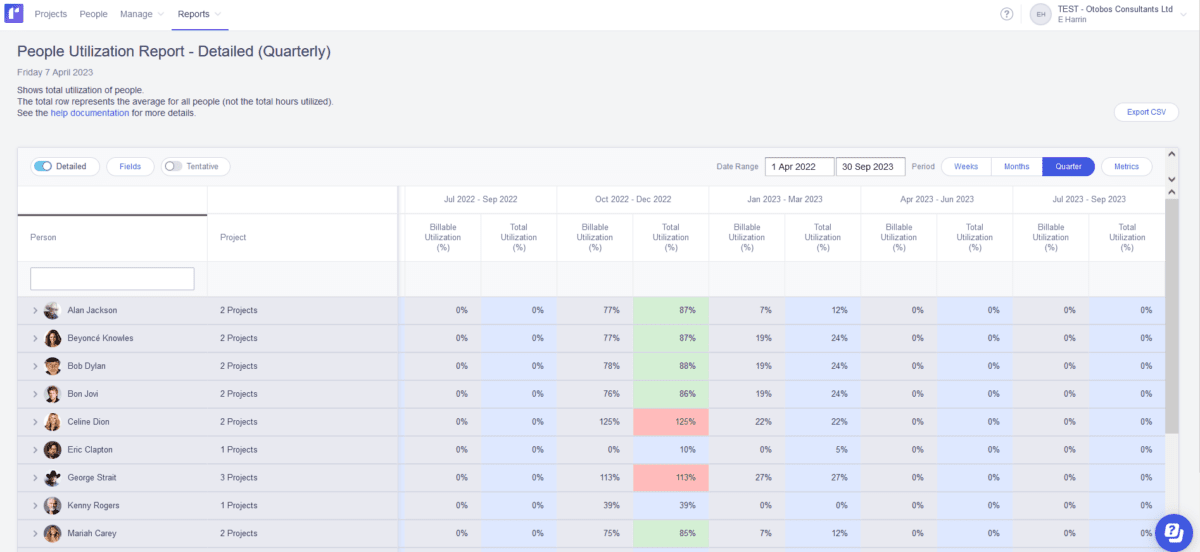Leveling vs Smoothing: What’s the Difference for Project Scheduling?
Resource management is a balancing act.
You’ve got a certain amount of people available and a certain amount of work to do. You know there are some techniques available to help you decide how best to use the available resources.
But when it comes to resource leveling vs resource smoothing, which would you choose for what situation?
What are the differences between these two approaches? What advantages or disadvantages come with each of them, and which should you choose for your project? Let’s take an in-depth look at both resource leveling and resource smoothing, compare the two techniques side by side, discuss when it makes sense to use one over the other – and finally provide some tips on implementing either approach into your own project management strategy.
Resource leveling
Resource leveling is a project management technique used to adjust the start and end dates of tasks in order to better manage limited resources. It involves analyzing the resource requirements of each task and then adjusting the schedule accordingly. This allows for improved resource utilization, increased efficiency, and reduced costs.
Let’s take an example.
Claire reviews the resource allocation reports in her project management software. It’s clear from the bar chart that resources are over-allocated. She’s got one person working at 125% of their available hours.

That might be OK as a one-off, if there is some blip that would help explain the overallocation. But let’s assume that the demand for resources is out of control and people are regularly overallocated throughout the project. Something has to give. Work/life balance is important to the organization, even when there are mission-critical activities that have to be done.
Claire needs that resource; no one else can step in. She changes the dates of the task so it is spread over a longer period.
Benefits of leveling
The primary benefit of resource leveling is improved resource utilization which can lead to increased efficiency and cost savings.
In other words, you are dealing with the fact that people have too much to do by spreading out the work so it takes longer. Then no one has to work overtime or risk burnout. Plus you can spot bottlenecks early and do something about them.
Generally, we use resource leveling when people are overallocated, but you could do the opposite: when people have plenty of time available, you can shrink down the project timescales.
By ensuring that all available resources are being used appropriately, projects can be completed faster… yes, really!
I know you’ve just spread out the project timeline by making tasks take longer so people actually have a fighting chance of being able to do them. But when resources are planned properly, you should have fewer delays due to lack of materials or personnel.
Limitations of leveling
One limitation of resource leveling is the difficulty in predicting future availability of resources such as people or materials, which could cause delays if not properly managed when you adjust the schedule. Get round this by checking they are available before pushing out the dates.
There might be other problems too, because shifting the dates might work for the people, but not other resources. Perhaps construction work can only be completed at the weekend when building users are not inside. You can’t simply extend the task for another few days and hope it will be OK – it won’t.
Keep replanning and monitoring throughout the duration of the project so your resource allocations remain effective. As and when new information becomes available (like weather conditions, staff holidays etc), revise your plans.
Resource leveling is a project management technique used to adjust the start and end dates of tasks in order to better manage resources. It can lead to improved resource utilization, increased efficiency, and cost savings but requires careful planning and monitoring throughout the duration of the project as conditions change.
When to use levelling
Leveling can be used when:
- You have the flexibility to change the overall duration of a project (or phase)
- You are able to change the critical path if you need to
- You have resources that are overallocated and you can’t add additional resource.
This approach is best when you have resource constraints.
Resource smoothing
Resource smoothing is a project management technique used to reduce fluctuations in resource usage over time by shifting tasks around within the project timeline.
It does not change the project duration. It does change what tasks are worked on when.
Smoothing is great for when resources are allocated unevenly. Let’s go back to Claire. She realizes that on her project, there is a 4-week period of time where she can’t add more time to the project. However, week 1 and week 4 are not very busy for the team. In weeks 2 and 3 they are flat out and are going to have to work overtime to get through all the tasks that have been assigned in that fortnight.
What can she do? She can smooth the profile of the work, and spread some of the workload from weeks 2 and 3 into weeks 1 and 4. Simple.
Smoothing requires you to analyze the resource requirements of each task and then adjust the schedule accordingly.
Benefits of smoothing
The main benefit of resource smoothing is the same as leveling: it’s a better use of your resource time. It stops people being rushed off their feet one moment and sitting around twiddling their thumbs the next.
If you bill clients for your time, it should reduce bench time and mean your resources are occupied on paying work.
Smoothing helps maintain a steady workflow and limits spikes in demand. You are creating a uniform resource utilization, give or take the practicalities of the work.
Smoothing – and resource optimization techniques in general – help you ensure the project is completed efficiently and successfully, by planning ahead and managing the flow of work at a constant level through the team.
Limitations of smoothing
Smoothing doesn’t work in all situations. In Claire’s example, her project tasks look like this:
Week 1: software design
Weeks 2 and 3: software build
Week 4: software testing
She can’t move tasks from week 3 into week 1 – you can’t build the thing before you’ve designed it. Equally, you can’t smooth work from week 2 into week 4 – it has to be fully built before you can test it.
So smoothing works when there are tasks that can be done in parallel. You’ll have to analyze your plan and see what options you have.
Watch out for the possibility of rework – if you bring forward a task, you might have other tasks that will change it later… consider the risk of having to do it again if something fundamentally changes.
Other general limitations also apply: any time you move work around you need to know people are available to do it. Packing work into a different ‘pattern’ means you might struggle if someone is off sick or there’s some other issue that means people aren’t available.
You also have to be quite flexible and able to drop something and move to another task. If your organizational culture doesn’t support this, that
When to use smoothing
Smoothing is the best option when:
- You have time constraints that have to be met
- At least some tasks can be worked on in parallel
- You can’t change the critical path.
This approach is best when you have time constraints. And ideally for when you have an alternative resource you can bring in to do some of the tasks if they happen in a different order.
Read next: What to do when your team doesn’t believe the project schedule.
Comparison of leveling and smoothing
So which one should you choose? Both methods have their advantages and disadvantages, so it is important to understand the similarities and differences between them in order to choose the right one for your project.
| Leveling | Smoothing | |
|---|---|---|
| Best for | Dealing with resource constraints | Dealing with time constraints |
| Does the project timeline change? | Yes | No |
| Task implications | Workload is spread over longer period | Workload is shifted around to even out demand |
| Resource implications | Probably doesn’t require more staff | Might require more staff |
Similarities
The primary goal of both resource leveling and smoothing is improved resource utilization, increased efficiency, and reduced costs. Both are made easier by having software tools that can do the heavy lifting or modeling for you.
Both help address team morale and avoid burnout, protecting critical resources (i.e. people).
Both might end up involving additional costs if you have no choice but to add people or delay work.
Differences
Resource leveling focuses on ensuring that resources are not over-allocated during any given time period while smoothing focuses on reducing fluctuations in resource usage over time by shifting tasks around within the overall project completion dates.
Having said that, you can use both at different, or the same points in your project. Don’t feel limited to one approach if you can make use of them both.
How to level or smooth
When implemented correctly, these methods can help projects stay on track and within budget, but I think the best reason to do it is to make sure your key people don’t quit.
Whether you are smoothing or leveling, the steps are the same:
- Review the current resource allocations and the project schedule
- Consider what the resource availability would be if you make a change – are you delaying work and pushing it into someone’s vacation time, for example.
- Adjust the schedule so the tasks happen when is best for them to happen. Change the start and end dates manually or change the dependencies so tasks can start earlier or later.
- Review what the schedule now looks like and what that has done to the resource profile of the work.
- Repeat until you are happy.
Your next steps
Resource leveling and resource smoothing are two different techniques for managing project resources. Are you ready to use them? Here are your next steps.
- Check out the resource reports in your project management software. Look for people or timeframes that are in red (typically, overallocation will show as red in most products).
- Talk to the people who are flagged as overallocated. Are they really overallocated? Or did they mess up their estimates? Check in with them before you go to the effort of altering the schedule.
- Spend some time going through the schedule to see where you can make changes.
- Discuss the impact of the changes with the people who need to know: normally your project sponsor and the rest of the team.
- Make the changes and let people know.
Both methods have their advantages and disadvantages, so it’s important to consider which one will work best for your project before implementing either technique. Ultimately, the decision of whether to use resource leveling or resource smoothing should be based on what works best for your particular project goals and timeline.
No matter which method you choose, understanding how each approach works can help you manage projects more effectively and efficiently using these powerful tools.
Pin for later reading

